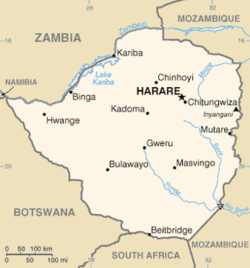Geography of Zimbabwe
 
|
|
| Continent | Africa |
|---|---|
| Region | Southern Africa |
| Coordinates | 20°S 30°E / 20°S 30°ECoordinates: 20°S 30°E / 20°S 30°E |
| Area | Ranked 63rd |
| • Total | 390,757 km2 (150,872 sq mi) |
| Coastline | 0 km (0 mi) |
| Borders | 3,066 km (Botswana 813 km, Mozambique 1231 km, South Africa 225 km, Zambia 797 km) |
| Highest point |
Inyangani 2,592 m |
| Lowest point | junction of the Runde and Save rivers. 162 m |
| Longest river |
Zambezi River 2,650 km |
| Largest lake |
Lake Kariba 7,770 km2 |
Zimbabwe is a landlocked country in southern Africa lying wholly within the tropics. It straddles an extensive high inland plateau that drops northwards to the Zambezi valley where the border with Zambia is and similarly drops southwards to the Limpopo valley and the border with South Africa. The country has borders with Botswana 813 km, Mozambique 1,231 km, South Africa 225 km, Zambia 797 km and meets Namibia at its westernmost point.
It is the 61st largest country in the world (although below average size for Africa) just larger than Japan but smaller than Paraguay, with a total area of 390,757 km², of which 3,910 km² comprises lakes and reservoirs.
The climate is tropical, although markedly moderated by altitude. There is a dry season, including a short cool season during the period May to September when the whole country has very little rain. The rainy season is typically a time of heavy rainfall from November to March. The whole country is influenced by the Intertropical Convergence Zone during January. In years when it is poorly defined there is below average rainfall and a likelihood of serious drought in the country (as happened in 1983 and 1992). When it is well-defined rainfall is average or well above average, as in 1981 and 1985.
Much of the country is high plateau with higher central plateau (high veld) forming a watershed between the Zambezi and Limpopo river systems. The Limpopo and the lower Zambezi valleys are broad and relatively flat plains. The eastern end of the watershed terminates in a north-south mountain spine, called the Eastern Highlands.
Elevation extremes:
lowest point: junction of the Runde and Save rivers 162 m
highest point: Mount Nyangani 2,592 m
Natural resources: coal, chromium ore, asbestos, gold, nickel, copper, iron ore, vanadium, lithium, tin, platinum group metals
...
Wikipedia
